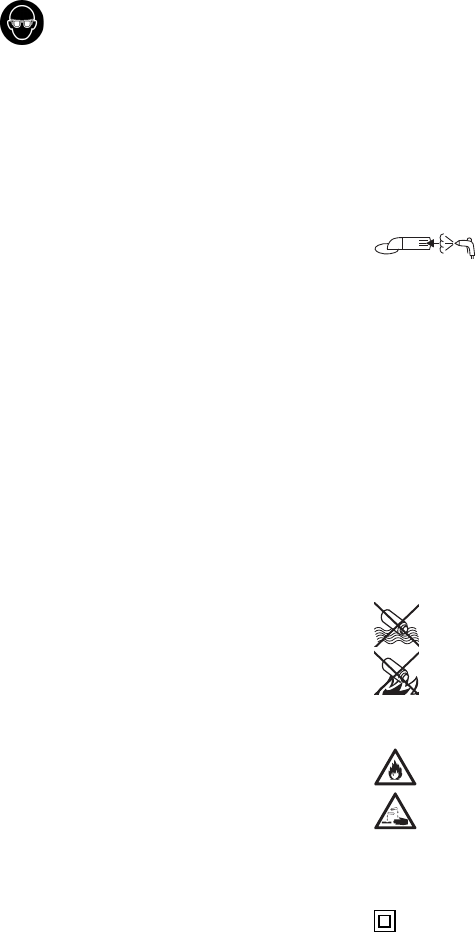
ENGLISHen
8
b) If the use of a safety guard is recommended
for wire brushing, do not allow any interference
of the wire wheel or brush with the guard. Wire
wheel or brush may expand in diameter due to work
load and centrifugal forces.
3.7 Additional Safety Instructions
WARNING – Always wear protective
goggles.
Use elastic cushioning layers if they have been
supplied with the abrasive and if required.
Observe the specifications of the tool or accessory
manufacturer! Protect the discs from grease or
impacts!
Grinding discs must be stored and handled with
care in accordance with the manufacturer's instruc-
tions.
Never use parting grinder discs for roughing work.
Do not apply pressure to the side of parting grinder
discs.
The workpiece must lay flat and be secured against
slipping, e.g. using clamps. Large workpieces must
be supported adequately.
If accessories with threaded inserts are used, the
end of the spindle may not touch the base of the
hole on the grinding tool. Make sure that the thread
in the accessory is long enough to accommodate
the full length of the spindle. The thread in the
accessory must match the thread on the spindle.
See page 3 and chapter 13. Technical Specifica-
tions for more information on the spindle length and
thread.
Dust from material such as paint containing lead,
some wood species, minerals and metal may be
harmful. Contact with or inhalation of the dust may
cause allergic reactions and/or respiratory diseases
to the operator or bystanders.
Certain kinds of dust are classified as carcinogenic,
such as oak and beech dust, especially in
conjunction with additives for wood conditioning
(chromate, wood preservative). Material containing
asbestos must only be treated by specialists.
- Use a dust extraction device where possible.
- The work place must be well ventilated.
- The use of a dust mask of filter class P2 is recom-
mended.
Follow national requirements for the materials you
want to work with.
Materials that generate dusts or vapours that may
be harmful to health (e.g. asbestos) must not be
processed.
When working in dusty conditions, ensure that
ventilation openings are not blocked. If it becomes
necessary to remove dust, first disconnect the
power tool from the mains supply (use non-metallic
objects) and avoid damaging internal components.
Damaged, eccentric or vibrating tools must not be
used.
Avoid damage to gas or water pipes, electrical
cables and load-bearing walls (static).
Connect a FI circuit-breaker with max.
release current (30 mA) upstream when using the
machine outdoors!
A damaged or cracked additional handle must be
replaced. Never operate a machine with a defective
additional handle.
Do not use safety guards that are damaged. Before
use, check the safety guards for cracks, deforma-
tions or signs of severe wear and tear.
This power tool is not suitable for polishing work.
Improper use of the machine will void the warranty!
The motor may overheat and damage the electric
power tool. We recommend using our angle
polisher for polishing work.
3.8 Special safety instructions for mains
powered machines:
Pull the plug out of the plug socket before any
adjustments, conversions or servicing are
performed.
During machining, of metals in
particular, conductive dust can form
deposits inside the machine. This can lead to the
transfer of electrical energy onto the machine
housing. This can mean a temporary danger of
electric shocks. This is why it is necessary when the
machine is running to blow compressed air through
the rear ventilation slots of the machine regularly,
frequently and thoroughly. Here, the machine must
be held firmly.
We recommend using a stationary extractor system
and connecting a residual current circuit-breaker
(FI) upstream. When the machine is shut down via
the FI circuit-breaker, it must be checked and
cleaned. See chapter 8. Cleaning for more
information on cleaning the motor.
3.9 Special safety instructions for cordless
machines:
Remove the battery pack from the machine before
any adjustments, conversions or servicing are
performed.
Protect battery packs from water and mois-
ture!
Do not expose battery packs to naked flame!
Do not use faulty or deformed battery packs!
Do not open battery packs!
Do not touch or short-circuit battery packs!
Slightly acidic, flammable fluid may leak from
defective li-ion battery packs!
If battery fluid leaks out and comes into
contact with your skin, rinse immediately
with plenty of water. If battery fluid leaks out
and comes into contact with your eyes, wash them
with clean water and seek medical attention imme-
diately.
SYMBOLS ON THE TOOL:
..........Class II Construction
V..............volts
A..............amperes


















